I think Japan still would have invaded the Soviet Union though, if the Second Sino-Japanese War continued (the oil embargo only really happened once they invaded Indochina).
Other than that I agree with you. That would be curious alternate reality.
Paratroopers of Easy Company, 506th PIR, “Band of Brothers”, in the square of Sainte-Marie-du-Mont, D+1.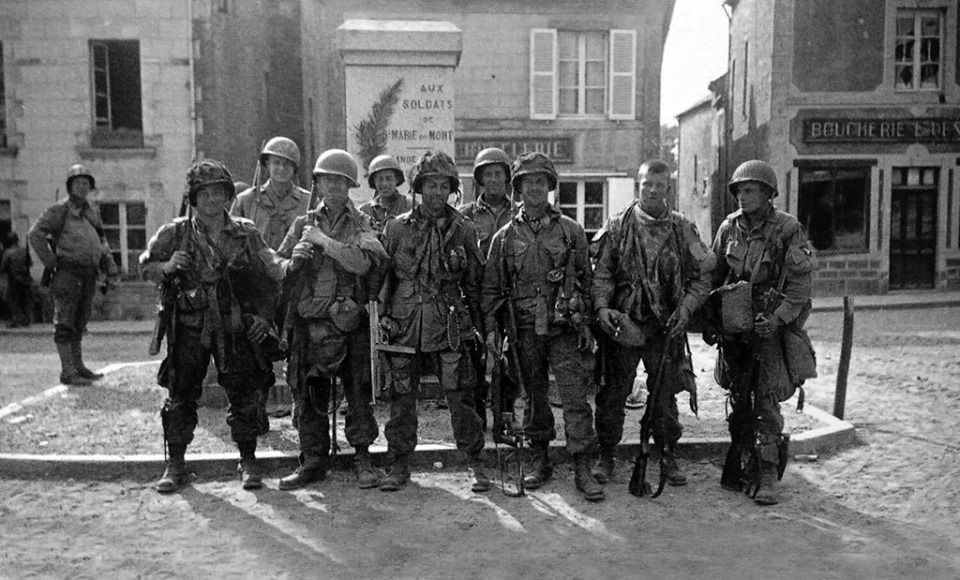
On this day in 1944. More of 7th Armoured Division arrive on Gold. Cromwell ‘T121766W’ from ‘A’ Squadron, 4th County of London Yeomanry leads the way. The ‘W’ indicates a welded tank with armour up to 100mm thick!
Imperial War Museum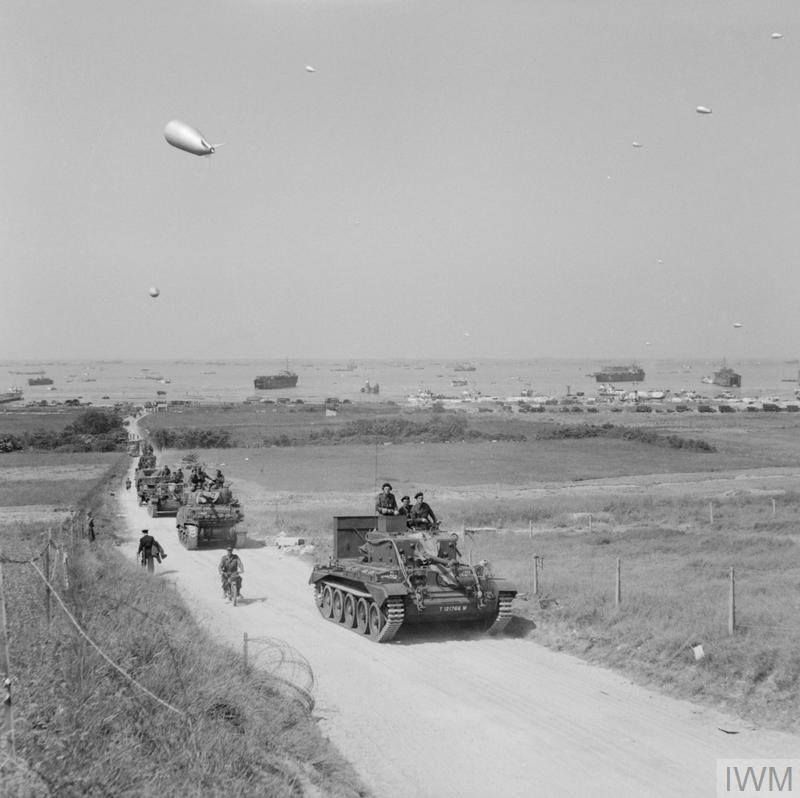
No particular date on this one but here’s a cool pic of a camouflaged German Bf 109 on flight above the Libyan desert, Summer 1941.

June 8, 1940. Norway
Evacuation of Narvik. French and Polish troops, pursuing General Dietl’s forces towards Sweden, pull out overnight and return to Narvik leaving dummies to fool the Germans. Group II troopships embark the final 4600 Allied troops (British, French and Polish) and depart Narvik, escorted by aircraft carrier HMS Ark Royal, cruisers HMS Southampton and HMS Coventry and 11 destroyers. The convoy is spotted by German reconnaissance planes and bombed continuously until out of range but without damage. Germans quickly assess the withdrawal and retake Narvik.
Operation Juno. German cruiser Admiral Hipper sinks British tanker Oil Pioneer and escorting armed trawler HMS Juniper (20 lives lost, Hipper picks up 29 survivors). Later, Hipper sinks empty British troopship Orama (19 lives lost, 280 rescued by German destroyers) but spares hospital ship Atlantis. Atlantis obeys the rules of war and does not attempt to radio any signals; Hipper does not sink her.
Operation Juno meets Evacuation of Narvik. At 0300 hours, aircraft carrier HMS Glorious sails for Scapa Flow with destroyers HMS Ardent & HMS Acasta (these vessels are not needed to escort troop transports). Captain Guy D’Oyly Hughes does not post top look-outs or fly patrol aircraft and runs into German battleships Scharnhorst and Gneisenau, 170 miles off the Norwegian coast. At 1630 hours, Scharnhorst and Gneisenau open fire from 24km, one of the longest hits ever recorded. Glorious is hit with several 11 inch shells, preventing aircraft taking off. Ardent & Acasta lay smoke and close on the German battleships firing 120 mm guns and torpedoes but both are hit. Acasta hits Scharnhorst with 1 torpedo (50 dead). Ardent sinks at 1720 hours (151 lives lost, 2 survivors). Glorious sinks at 1910 hours (1162 sailors and 59 RAF personnel killed, 42 survivors). Acasta sinks at 1920 hours (161 dead, 2 survivors). Admiral Wilhelm Marschall, aboard his flagship Gneisenau orders his flag lowered to half mast to honour the crews of the British destroyers. Photo is Scharnhorst firing on HMS Glorious.

Source: worldwar2daybyday
A Panzer crew, belonging to 1./s.SS-Pz.Abt.101 “Leibstandarte-SS-Adolf-Hitler” are here seen camouflaging their Panzer VI ‘Tiger’ tank with tree branches in the vicinity of Villers-Bocage, Normandy, in June 1944.
Date unconfirmed but possibly taken on the 14th of June, on the Ancienne Route de Caen (the old Caen Road), where Michael Wittmann’s company spent the night of 12/13 June.
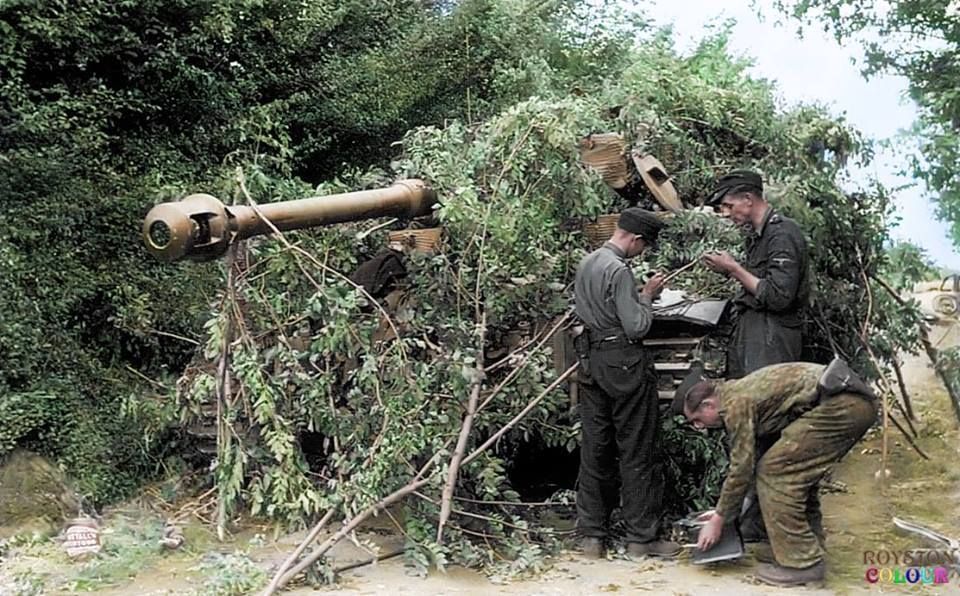
11 JUN 1944: My uncle, Bud Piper, a combat engineer in the U.S. Army, began his second day in France. Like yesterday and tomorrow, he would spend it on his hands and knees, removing mines from Omaha Beach. By the end of the month, 1/3 of his unit would be killed or wounded by mines, booby traps, snipers or German artillery.
On this day in 1944, German Tiger tank commander Wittmann stops the entire British 7th Armoured Division advance to Caen, “single-handedly”, at Villers-Bocage. Wittmann destroyed in less than fifteen minutes 13 tanks, 2 anti-tank guns and 14 transport vehicles.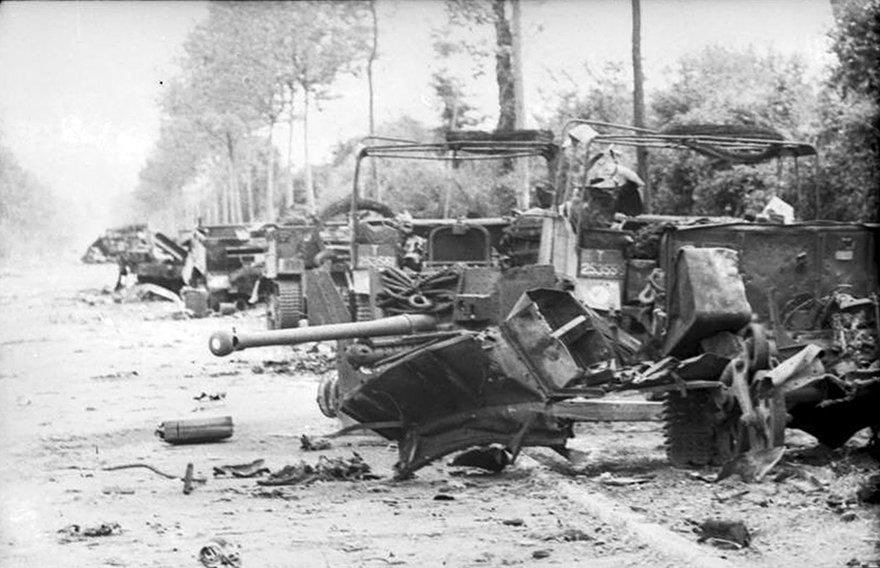
Ha my hero ! 😬
Wrecks of German Tiger 1 & Panzer IV Tanks, Villers-Bocage, 13th June 1944
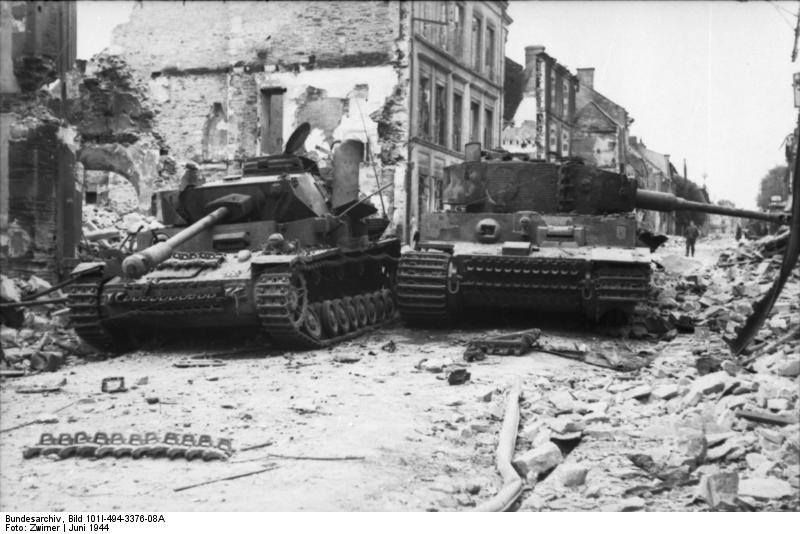
Bummer. Lol. Nice pics
13th June 1944: London;
The V1 Flying Bomb, ( Hitler’s Vergeltungswaffe 1, Vengeance Weapon 1) known by The Allies as Buzz Bombs or Doodlebugs was an early cruise missile & the only production aircraft to use pulsejet for power.
The Wehrmacht started launching the V1’s in mid 1944. A total of 9,521 were fired at London & the South East Coast, the first hitting London, next to a railway bridge, on Grove Road, Mile End, on 13th June 1944, killing 8 civilians. The last V1 hit the UK in October 1944, when the sites were overrun by the advancing Allies, after which they targeted Belgium, until 29th March 1945.
Several methods were incorporated to Destroy the V1’s, Anti-aircraft guns & Barrage Balloons being two of them. The Third was the Interceptor, (Fighter Aircraft). Early attempts to Intercept the V1’s often failed, but improved techniques soon emerged. One of these was the use of airflow over the Interceptors Wing to raise one wing of the V1, by sliding the wingtip to within 6 inches (15cm) of the lower surface of the V1’s wing, (as shown in photographs below)
When properly executed, this manoeuvre would tip the V1’s wing up, thereby overriding the gyro & sending the V1 into an out of control dive. At least 16 V1’s were destroyed this way, the first by Major R E Turner, of 356th Fighter Squadron on the 18th June 1944;
The total number of casualties inflicted by the V1’s was 22,892.
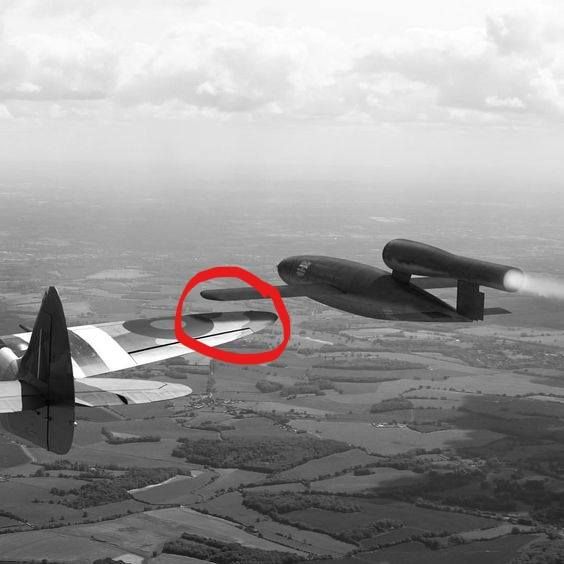
A British 4.5 inch gun & crew of 211 Battery, 64th Medium Regiment, R>A> in action near Tilly-sur-Seulles, 13th June 1944: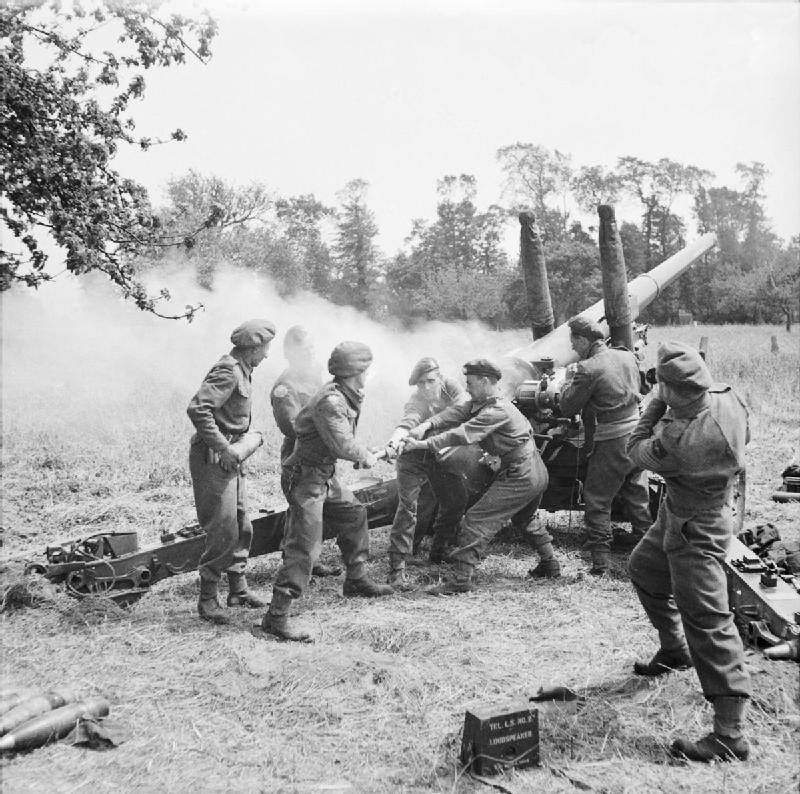
@captainwalker Villers Bocage is a sleepy old town. Had to go and sit there and drink a beer, thinking of that famous day and his exploits. The British column. and the 7th as a whole, were totally paralyzed by his actions that day. Well worth reading about it.
@captainwalker said in On this day during W.W. 2:
13th June 1944: London;
The V1 Flying Bomb, ( Hitler’s Vergeltungswaffe 1, Vengeance Weapon 1) known by The Allies as Buzz Bombs or Doodlebugs was an early cruise missile & the only production aircraft to use pulsejet for power.
The Wehrmacht started launching the V1’s in mid 1944. A total of 9,521 were fired at London & the South East Coast, the first hitting London, next to a railway bridge, on Grove Road, Mile End, on 13th June 1944, killing 8 civilians. The last V1 hit the UK in October 1944, when the sites were overrun by the advancing Allies, after which they targeted Belgium, until 29th March 1945.
Several methods were incorporated to Destroy the V1’s, Anti-aircraft guns & Barrage Balloons being two of them. The Third was the Interceptor, (Fighter Aircraft). Early attempts to Intercept the V1’s often failed, but improved techniques soon emerged. One of these was the use of airflow over the Interceptors Wing to raise one wing of the V1, by sliding the wingtip to within 6 inches (15cm) of the lower surface of the V1’s wing, (as shown in photographs below)
When properly executed, this manoeuvre would tip the V1’s wing up, thereby overriding the gyro & sending the V1 into an out of control dive. At least 16 V1’s were destroyed this way, the first by Major R E Turner, of 356th Fighter Squadron on the 18th June 1944;
The total number of casualties inflicted by the V1’s was 22,892.
I read about the V-1 but didn’t know it did that much in casualties. I know they were shot down or as u were saying thrown off track and such.
Ya I know in a game where figs can intercept them.
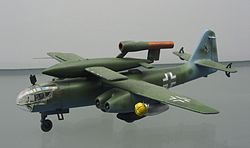 https://en.m.wikipedia.org/wiki/File:Arado_Ar_234_Blitz_mit_V1_pic1.JPG
https://en.m.wikipedia.org/wiki/File:Arado_Ar_234_Blitz_mit_V1_pic1.JPG
It’s funny how a missile was made to look like a plane. Needed the wings for guidance.
Just think if they had that weapon at start of war in 39. Who knows with that they would of had the jump on allies maybe for a couple of years. But that’s a but and the allies may have countered it early too just like they did in 44 45.
Another thought. Technology wise the Germans invented the Kami attack first. Japan also received the motor for this V-1 rocket/missile/plane in 1943 by German sub and plans were found where the Japs had plans for 3 types of launch mechanizations and 1 of them was from a sub.
This would be a good event card in my game where Japan gets a free attempt at Rockets or something to that effect.
9-11 is another example too unfortunately.
@SS-GEN said in On this day during W.W. 2:
It’s funny how a missile was made to look like a plane. Needed the wings for guidance.
Just think if they had that weapon at start of war in 39. Who knows with that they would of had the jump on allies maybe for a couple of years. But that’s a but and the allies may have countered it early too just like they did in 44 45.
The reason V1 had wings (in contrast with the finned V2) wasn’t really a matter of guidance, it was a matter of how much energy it takes to move a mass of x kilograms over a distance of y kilometers (in this case, from France to London) at a speed of z kilometers per hour. The purpose of the V1’s wings, like those of a conventional aircraft, was to provide lift and thus give the V1 the ability to fly in a conventional manner on a more or less horizontal flight path. The V1, which weighed two tons, could get from point A to point B at 640 kph, on a relatively modest amount of fuel. The V2, by contrast, weighed six times more and travelled nine times faster; it followed a ballistic trajectory rather than a horizontal flight path, which is why it didn’t need wings. The trade-off, however, was a ballistic missile requires much greater thrust than an aircraft, which in turn requires larger quantities of more energetic fuel. Also note that rockets like the V2 need to carry their own fuel oxidizer, whereas air-breathing jet aircraft like the V1 don’t, which is another reason why jets can sustain themselves in flight on a relatively modest fuel load.
The question of whether the V1 and the V2 could have altered the outcome of WWII if they’d been developed, let’s say, about five years earlier is an interesting one; my impression is that, in and of themselves, they would not have done so, even if they’d been deployed in much larger quantities. The V1 and V2 were basically an expensive and inefficient alternate way (in terms of their bang-for-the-buck ratio) of bombing a city with low precision, so in that respect Germany would have been better off developing a proper heavy bomber design and a proper long-range escort fighter and producing both in large quantities. The only unquestioned advantage which the V2 had over any conventional bomber, or the V2, was that it was impossible for the defenders to intercept it once it was launched. Which brings me back to the “in and of themselves” point I mentioned earlier: the V2 by itself was not a weapon which could have changed the outcome of WWII, but if it had been equiped with an atomic warhead it would have been a serious strategic threat to the Allies. But even here, we have to be careful about jumping to conclusions. First, the German atomic program was years behind that of the US – and even the US, which devoted huge resources to the Manhattan Project, only produced (and detonated) three bombs (one was a test device) by the summer of 1945 (by which time Germany had already surrendered). So even if we were to assume (and it’s a big assumption) that Germany could have matched the Manhattan Project, and even done better by assembling its bombs a year earlier than the Americans did, the question becomes: would the Allies have surrendered if, let’s say, London and Moscow had each been nuked in mid-1944 by a V2 with a kiloton-level atomic warhead? The Russians, who’d already lost tens of millions of people and who’d seen huge areas of their countries devastated by conventional warfare, would certainly have kept going, and would probably have been even more determined than before to take their revenge against Nazi Germany. The Americans would also have kept going, with an even greater conviction than before that Nazi Germany was enormously dangerous and had to be stopped by any means possible. And my guess is that even the British would have kept going: they would have known from their intelligence sources that Germany had used up its tiny supply of warheads and they would have known that by that date the momentum of the war was on the Allied side. Furthermore, it’s hard to imagine what the practical details of a British surrender would have looked like in mid-1944, given that up until D-Day Britain was basically the operational base of a gigantic American army which, presumably, would not have meekly gone back home if Churchill – in a completely out-of-character move – would have told Eisenhower, “Thanks, but we don’t need you anymore.”
Ha. That line “Hey we don’t need you now” is like any country dreaming. Anyway
Awesome reply and as for guidance ya my thought was in line of lift and such as you mentioned.
My thought on v-1 was mainly for like groups of inf. Supply and fuel depots and some city’s starting in 39. But as u said to early as far as war was and accuracy.
“we don’t need ya now” lol good one. Reminds of the Tehran conference. i don’t remember the story exactly, but basically it was
After the war the US/UK will leave Persia but whose gonna make the russians leave ? We invaded Iran and split it with Russia, which we think is good. The Germans invaded Poland and split it with Russia, which we think is bad.
So appealing to Stalin’s better nature probably won’t work.
Anyway some language was put into the agreement that russia had to leave after the war. Truman had to give’em hell, no pun intended, to get them to leave, but they did.